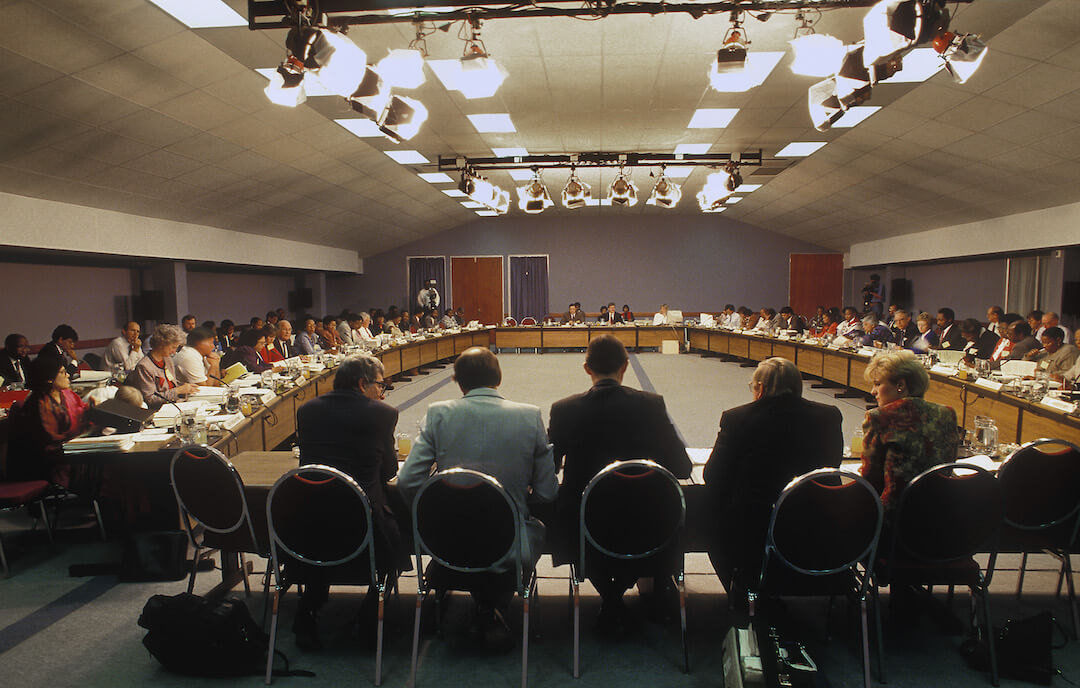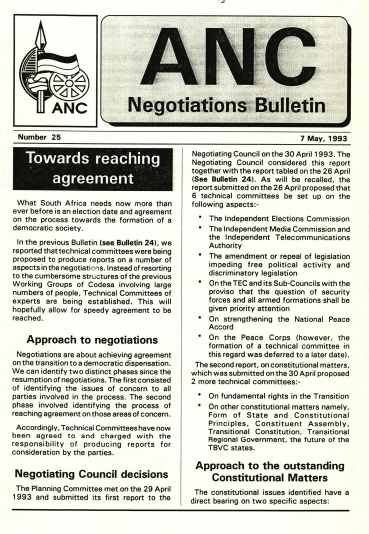The story of the MPNP
1 APRIL 1993

Robert Botha
New
participants:
Though it was smaller in terms of numbers, more parties participated in the process. For the first time, the Pan Africanist Congress (PAC) and the Conservative Party (CP) came to the table. Only the Azanian People’s Organisation (AZAPO) and several extreme Afrikaner parties refused to join.
The
challenge:
It was now a race against time for the MPNP to produce an Interim Constitution by the end of 1993. But there was a renewed spirit of hope based on the shared commitment to a common voters roll in a unified and undivided South Africa. The foundation was now set. There was also a new sense of urgency after the multiple breakdowns and deadlocks of the preceding months.
Modus
operandi:
The MPNP structure was far less unwieldy than that of the Convention for a Democratic South Africa (CODESA). The highest decision-making body was the 26-party, parliamentary-style plenary. Day-to-day negotiations and decision-making were undertaken by a Negotiating Council that met three to four days a week. In addition, the process was to be streamlined with a greater role given to legal technicians and experts in terms of drafting documents. Both Arthur Chaskalson and Dikgang Moseneke, later becoming the Chief Justice and Deputy Chief Justice of the Constitutional Court respectively, were integral in steering the process forward and getting groups of people working effectively towards a common goal. Women’s representation as delegates at the negotiating table was still a burning issue that led to protest and petitions by the Women’s National Coalition.
The benefit of the
Technical Committees:
Instead of political groups putting their positions verbally to one another in the MPNP’s Negotiating Council, as happened at CODESA, written submissions were now presented to the committees. This avoided grandstanding and entrenching of positions. Most of the seven committees’ reports to the Council already contained the seeds of compromise and this avoided political acrimony. Although formally prohibited from ‘meddling’ in political issues, the committees acted as compromise-seeking and deadlock-breaking mechanisms and shifted the emphasis from the political to the technical. Technical Committee 2’s brief was ‘constitutional issues’.
The
outputs:
In addition to the Interim Constitution, four other Draft Bills providing for the transition structures for the period of preparation for the elections were agreed upon: the Transitional Executive Council (TEC); the Independent Electoral Commission (IEC); and the Independent Media Commission; and a permanent body to control broadcasting (the Independent Broadcasting Authority). A new Electoral Act to govern the elections for the Constitutional Assembly was also agreed to.
The
atmosphere:
People often worked 48 hours at a stretch, and despite the relentless pace of the negotiations, camaraderie grew among the members. As a result, rapid progress was made. Technical report after technical report piled up on many contentious issues.
In their own words
“A not-so-well known structure of the Planning Committee was the so-called ‘sub-committee’, consisting of Messrs Mac Maharaj, Ben Ngubane, and Fanie van der Merwe … Acting as ‘troubleshooters’, advisers and strategists, the members of the sub-committee [kept] a low profile, thereby enhancing their effectiveness. The fact that, [they] spanned the political spectrum, gave it a certain degree of legitimacy which proved crucial … The sub-committee constituted a deadlock-breaking mechanism with no precedent.”
-Dr Theuns Eloff, then Head of the Administration at the MPNP
“When the issue of administration of the negotiations cropped up, there were lots of issues. This is where Fanie and Mac were so important … In managing the process and deciding how the groups would be structured. The MPNP wasn’t just a different name, it was a different structure.”
–Albie Sachs, then ANC negotiator at the MPNP
“A phrase from the MPNP that was heard over and over again was ‘Well, the technical negotiators have come up with a solution. We can live with it’.”
-Hassen Ebrahim, then National Coordinator of the ANC’s Negotiation Commission
“The lesson from CODESA was learnt, and a non-partisan body, the Consultative Business Movement, was contracted to provide the administrative and secretarial back-up … This contributed to the smooth and effective running of not only the administration, but also of the process.”
–Dr Theuns Eloff, then Head of the Administration at the MPNP, in a personal reflection on the lessons learnt from CODESA, 1994
“As Cyril, Roelf and others negotiated something, they came to us and said, ‘We have a deal,’ and we said, ‘What’s the deal?’ We were the guys who wrote it all into legalese. We provided some glue to the whole process. It wasn’t a political role. I fell back on my lawyering skill … and provided leadership when it was crucial just before the transition.”
-Dikgang Moseneke, then advocate and one of eight who drafted the MPNP agreements
“On the spot legal advice helped to unlock political differences.”
–Roelf Meyer, then chief negotiator for the NP
“Women in political parties began to demand inclusion on the decision-making teams. At that session [of all women representatives from the parties], women demanded ‘the establishment of a Women’s Caucus … to resolve the issue of women’s participation once and for all.’”
-Shireen Hassim, professor of sociology and activist
“No attempt was made [by political parties] to balance the presence of men and women in the composition of the technical committees or to include gender rights specialists … Even those parties who publicly pronounce non-sexist policies and thrive on a progressive image in the whole area of gender equality have failed to adopt a serious approach.”
–Leon Wessels, then Cabinet Minister and NP negotiator at the MPNP









